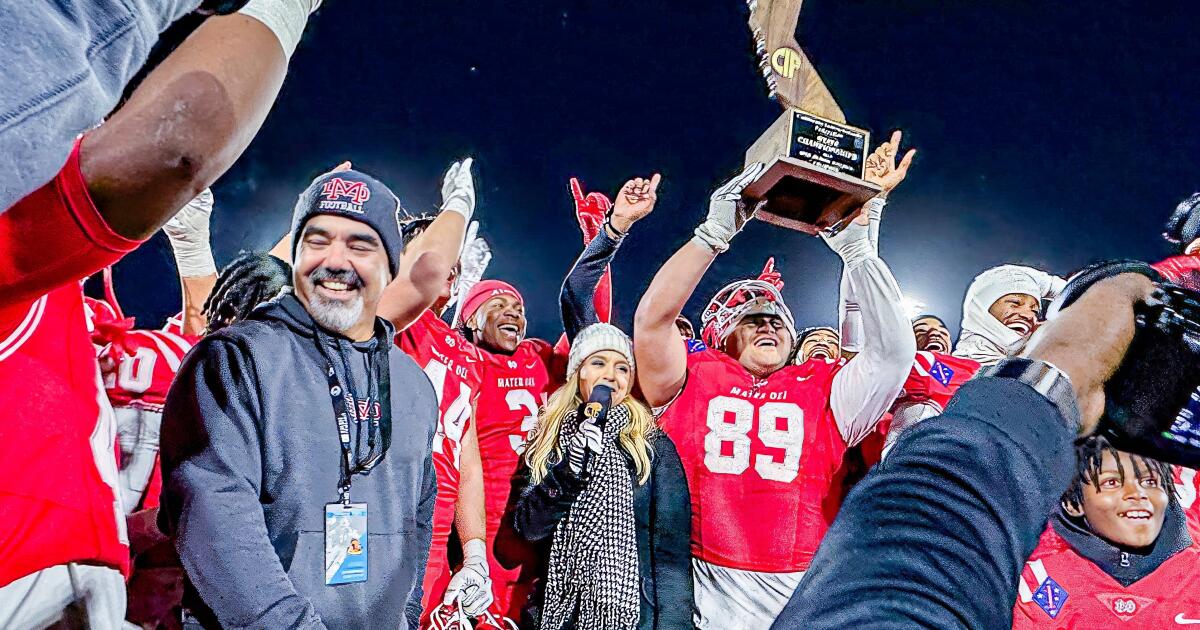De La Salle is determined to end Northern California losing streak
Interest in the CIF Open Division state championship football game has diminished during an eight-game Northern California losing streak dominated by Mater Dei and St. John Bosco. Every time De La Salle or San Mateo Serra has shown up via bus or plane, the result has been the same.
Not since 2015 has a Southern California team lost in the top division. Now that Northern California teams know how Southern California teams felt when losing from 2007 through 2012, is it time for Northern California to end its losing streak?
De La Salle (12-0) was chosen Sunday to face Southern Section Division 1 champion Santa Margarita (10-3) in the Open Division final on Dec. 13 at 8 p.m. at Saddleback College. Coach Justin Alumbaugh insists there are signs his program is capable of ending the streak.
“I thought we had a chance last year,” he said, referring to a 37-15 loss to Mater Dei. “Mater Dei was incredible. But if we played a near-perfect game . . . we closed the gap. I liked our team last year and I like our team this year.”
In Southern California, change has happened. Neither Mater Dei nor St. John Bosco will be in the Open Division final for the first time since 2015. But that hardly means a drop in ability for the state championship. Everyone agrees the Southern Section Division 1 playoffs might be the best in the country, and Santa Margarita won the title by getting better each week, ending with a 42-7 rout of Corona Centennial on Friday night.
“Wow,” Alumbaugh said after watching the game at the Rose Bowl. “To hold Corona Centennial to seven points is one of the more impressive things.”
Alumbaugh brought along his 8-year-old son, and while Trent Mosley was catching 10 passes for 292 yards, his son asked, “Why don’t they stop No. 4?”
Now it’s going to be Alumbaugh’s problem.
De La Salle has a 22-day layoff before facing Santa Margarita, and Alumbaugh has “destroyed” plans from last season‘s game against Mater Dei trying to get his team to start better.
“Santa Margarita is really, really good,” Alumbaugh said. “The names might be different since 2015, but it doesn’t mean the caliber of team isn’t good.”
What gives De La Salle hope is its speed and balance on offense. The Spartans have three players who can run 100 meters in 10.5 seconds or faster, including the state’s fastest athlete, record holder Jaden Jefferson. Quarterback Brayden Knight is capable of completing clutch passes. And the defense has been particularly impressive with three shutouts.
“We’re showing up to compete,” Alumbaugh said. “That’s our mindset and in our blood. There were a couple years we knew we were overmatched. We have a good team. We can compete with any team in the country.”
That’s good news for fans bored with a running clock in the fourth quarter of championship games, such as when Serra lost 35-0 in 2023, 45-0 in 2022 and 44-7 in 2021.
But Santa Margarita coach Carson Palmer warned after his team’s win over Centennial, “We’re playing real good right now.”
Every section champion earned a state playoff berth, with regional action starting next weekend. The state finals are Dec. 12 and 13 at Saddleback College, Fullerton High and Buena Park High.
Los Alamitos and San Diego Cathedral Catholic will meet in the 1-AA regional final on Friday at Long Beach Veterans Stadiums, testing the Southern Section Division 2 champion against the San Diego Section Open Division winner. City Section Open Division champion Carson is in 3-A and will take Delano Kennedy at 6 p.m. on Saturday at home.
One of the best matchups is the only battle of the unbeaten teams, Rio Hondo Prep (14-0) taking on Solano Beach Santa Fe Christian (13-0) on Saturday at Carlsbad in 2-A.
